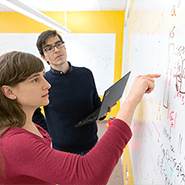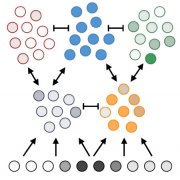There is mounting evidence that humans combine uncertain sensory information with prior knowledge to make inferences and decisions, and many hypothesize that this should be viewed from a Bayesian standpoint. Visual object recognition is a natural task in which uncertain bottom-up sensory information may be combined with top-down prior knowledge to reason, probabilistically, about visual scenes. Reconciling Bayesian theories of cognition with the apparent complexity of inference and learning, and demonstrating neurally-plausible mechanisms capable of implementing these theories, is an open problem. The neuroidal model provides a framework for concretely defining neural representations and algorithms, with an emphasis on learning. We seek to construct such Bayesian mechanisms in the neuroidal model and to explore the complexity and limitations of realizing these mechanisms in neural systems. There are three main goals of this project:
1. Develop algorithms for learning and inference in the neuroidal framework.
A great deal of recent work has focused on how neural circuits could represent uncertainty and perform inference, but little progress has been made on the question of how probabilistic models are initially learned. This task, known as the structure learning problem, could be thought of as probabilistic inference in a higher-level distribution over models. Stochastic gradient descent has been suggested as one general purpose learning algorithm. Alternatively, there exist a variety of methods for finding tree-structured graphical models and for learning causal directed acyclic graphs. Investigating potential neural implementations structure learning is a central goal of this project.
The choice of structure learning algorithm is intimately tied to the type of neural inference algorithm, which is in turn tightly coupled with the underlying representation of uncertainty. Tree-structured graphical models permit efficient inference via message-passing, but there are many other methods of inference. Maximum likelihood estimation, variational inference, and MCMC have all been suggested as potential neural inference algorithms. The question remains, which combinations of learning and inference algorithms are most suitable to the constraints of neural circuits?
This goal is intimately tied to the goals of CBMM Thrust 1, which emphasizes the role of general probabilistic programs, hierarchical Bayesian learning, and cognitively and biologically plausible inference mechanisms. It also aligns with the goals of Thrust 2, which is responsible for circuits that underly intelligence.
2. Explore neural representations of uncertainty that support efficient learning and inference.
In order to support probabilistic learning and inference, neural populations must somehow represent and encode uncertainty. Probabilistic population codes, sampling-based representations, and rate-based encodings of log probability are some of the leading contenders, but these must conform to the requirements of the inference and learning algorithm and the model of computation. Consideration of these constraints could render some representations more or less plausible.
3. Apply these theories to hard problems in probabilistic vision.
Vision is one of the most natural inference problems. How do we parse scenes under various viewing angles and lighting conditions with only two dimensional views the world? Choosing among the infinite number of three dimensional scenes that could have given rise to our observations requires some way to evaluate their relative likelihood.
This has long been recognized, and many Bayesian vision models have been posited. Translating these models into the neuroidal framework would yield a formal language for addressing the question of how these models could be learned, and how inference could be performed in neural circuits.
We will begin with visual tasks that are directly relevant to the CBMM and that are particularly suited to a probabilistic approach, such as object classification in inherently uncertain situations with noisy observations and incomplete data.


